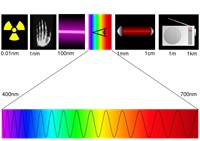|
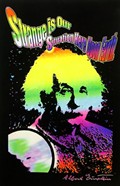 Of
all the cool things that can be done with lighting, blacklight
effects are probably the most fun! Its eerie and mysterious look can
really stimulate your imagination, and help you design that hippie
room, haunted house, or anything else you can think of. Of
all the cool things that can be done with lighting, blacklight
effects are probably the most fun! Its eerie and mysterious look can
really stimulate your imagination, and help you design that hippie
room, haunted house, or anything else you can think of.
The
best place to start in understanding blacklight technology is with
the electromagnetic spectrum, and that part of it that the human eye
responds to. Although
blacklight lamps appear to be a dark purple, the actual radiated
energy that causes the effects you see is outside the visible
spectrum and cannot be seen directly. The visible purple light
represents the inefficiency of the lamp and is wasted energy -
although it does look cool! The typical human eye responds to
electromagnetic energy between 400 & 700 nanometers. Below this
range is ultraviolet, x-ray, and gamma ray energy. Above this range
is infrared, microwave, and radio wave energy. The blacklight energy
that causes the fluorescent glow of certain materials lies within
the range of 320 & 400 nanometers in wavelength.
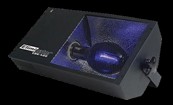
400 watt mercury vapor
blacklight source with filtered glass bulb |
The least expensive
blacklight source is an incandescent lamp with a filter coating
over the bulb. These are also the poorest types however, because
the filament emits only about 1 to 2 percent of its energy in
the effective region
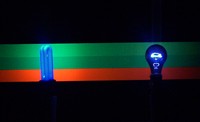
comparison between a 13
watt compact fluorescent blacklight and a 75 watt
incandescent type against reactive material |
below 400 nanometers. It won't have much
effect on your poster, and because the filtered glass absorbs
most of the other 98 or so percent of the radiant energy
they get extremely hot! The best and most popular blacklight sources
are fluorescent lamps with a special phosphor that is optimized
for energy output between 320 & 400 nanometers, and a filtering
glass to eliminate most of the visible light. These come in many shapes and sizes now,
both as a tubular type that operates in a ballasted fixture, and
a compact type which has an integral electronic ballast and uses
a standard screw base socket. The compact fluorescent type is
becoming popular, is also relatively inexpensive, and a superior
source to the incandescent lamp in terms of both efficiency and
effectiveness. The commercial entertainment industry often uses
higher powered mercury vapor lamps (such as the one shown) with
either a filtering glass bulb or fixture lens. These typically
come in sizes of 400 or 1,000 watts, and are useful for large
display areas such as performance stages or haunted house attractions.
So how does light that we
can't see show up as bright colors that we can? Blacklight posters,
|
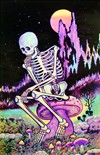
fluorescent ink
poster |

phosphorescent
materials |
paints, and glow-in-the-dark ghosts and skeletons all use
materials which are called blacklight-reactive. These work by absorbing photons
with a short wavelength (in the <400nm ultraviolet range) and
emitting photons in exchange with a longer wavelength that is
visible to us - such as green, yellow, or red. These blacklight-reactive
materials fall into two categories: fluorescent and phosphorescent.
Fluorescent paints, inks, or dyes glow only as long as they are
energized by ultraviolet light. Phosphorescent materials will absorb
and store this ultraviolet energy and continue to glow for a period
of time after the ultraviolet energy is removed. An example of this
would be glow-in-the-dark hands on an alarm clock that can be seen
after the room lights are turned off.
|


 Of
all the cool things that can be done with lighting, blacklight
effects are probably the most fun! Its eerie and mysterious look can
really stimulate your imagination, and help you design that hippie
room, haunted house, or anything else you can think of.
Of
all the cool things that can be done with lighting, blacklight
effects are probably the most fun! Its eerie and mysterious look can
really stimulate your imagination, and help you design that hippie
room, haunted house, or anything else you can think of.